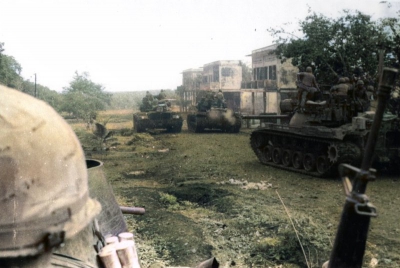The Khmer National Armed Forces (Khmer: ; French: Forces armes nationales khmres, FANK) were the official armed defense forces of the Khmer Republic, a short-lived state that existed from 1970 to 1975, known today as Cambodia. The FANK was the successor of the Royal Khmer Armed Forces (FARK) which had been responsible for the defense of the previous Kingdom of Cambodia since its independence in 1953 from France.
The Cambodian Civil War (Khmer: សង្គ្រាមស៊ីវិលកម្ពុជា) was a civil war in Cambodia fought between the forces of the Communist Party of Kampuchea (known as the Khmer Rouge, supported by North Vietnam and the Viet Cong) against the government forces of the Kingdom of Cambodia and, after October 1970, the Khmer Republic, which had succeeded the kingdom (both supported by the United States and South Vietnam).
The struggle was complicated by the influence and actions of the allies of the two warring sides. North Vietnam's People's Army of Vietnam (PAVN) involvement was designed to protect its Base Areas and sanctuaries in eastern Cambodia, without which it would have been harder to pursue its military effort in South Vietnam. Their presence was at first tolerated by Prince Sihanouk, the Cambodian head of state, but domestic resistance combined with China and North Vietnam continuing to provide aid to the anti-government Khmer Rouge alarmed Sihanouk and caused him to go to Moscow to request the Soviets rein in the behavior of North Vietnam. The deposition of Sihanouk by the Cambodian National Assembly in March 1970, following wide scale protests in the capital against the presence of PAVN troops in the country, put a pro-American government in power (later declared the Khmer Republic) which demanded that the PAVN leave Cambodia. The PAVN refused and, at the request of the Khmer Rouge, promptly invaded Cambodia in force.
Between March and June 1970, the North Vietnamese captured most of the northeastern third of the country in engagements with the Cambodian army. The North Vietnamese turned over some of their conquests and provided other assistance to the Khmer Rouge, thus empowering what was at the time a small guerrilla movement. The Cambodian government hastened to expand its army to combat the North Vietnamese and the growing power of the Khmer Rouge.The U.S. was motivated by the desire to buy time for its withdrawal from Southeast Asia, to protect its ally in South Vietnam, and to prevent the spread of communism to Cambodia. American and both South and North Vietnamese forces directly participated (at one time or another) in the fighting. The U.S. assisted the central government with massive U.S. aerial bombing campaigns and direct material and financial aid, while the North Vietnamese kept soldiers on the lands that they had previously occupied and occasionally engaged the Khmer Republic army in ground combat.
After five years of savage fighting, the Republican government was defeated on 17 April 1975 when the victorious Khmer Rouge proclaimed the establishment of Democratic Kampuchea. The war caused a refugee crisis in Cambodia with two million people—more than 25 percent of the population—displaced from rural areas into the cities, especially Phnom Penh which grew from about 600,000 in 1970 to an estimated population of nearly 2 million by 1975.
Children were widely used during and after the war, often being persuaded or forced to commit atrocities. The Cambodian government estimated that more than 20 percent of the property in the country had been destroyed during the war. In total, an estimated 275,000–310,000 people were killed as a result of the war.
The conflict was part of the Second Indochina War (1955–1975) which also consumed the neighboring Kingdom of Laos, South Vietnam, and North Vietnam individually referred to as the Laotian Civil War and the Vietnam War respectively. The Cambodian civil war led to the Cambodian genocide, one of the bloodiest in history.

1975Apr, 17
The Cambodian Civil War ends. The Khmer Rouge captures the capital Phnom Penh and Cambodian government forces surrender.
Choose Another Date
Events on 1975
- 26Jun
Pine Ridge Indian Reservation
Two FBI agents and a member of the American Indian Movement are killed in a shootout on the Pine Ridge Indian Reservation in South Dakota; Leonard Peltier is later convicted of the murders in a controversial trial. - 15Aug
Sheikh Mujibur Rahman
Bangladeshi leader Sheikh Mujibur Rahman is killed along with most members of his family during a military coup. - 15Aug
Yasukuni Shrine
Takeo Miki makes the first official pilgrimage to Yasukuni Shrine by an incumbent prime minister on the anniversary of the end of World War II. - 27Aug
Dili
The Governor of Portuguese Timor abandons its capital, Dili, and flees to Atauro Island, leaving control to a rebel group. - 1Oct
Ellice Islands
The Seychelles gain internal self-government. The Ellice Islands split from Gilbert Islands and take the name Tuvalu.

 English
English  español
español  français
français  português
português  русский
русский  العربية
العربية  简体中文
简体中文 